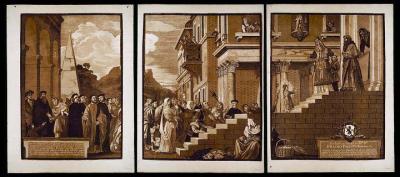In 1731, the British printmaker John Baptist Jackson arrived in Venice and found work with printmaker Count Antonio Maria Zanetti. Jackson impressed his employer with images printed from multiple blocks, dramatically reproducing paintings and sculpture in a two-dimensional format. He went on to have success designing and cutting woodcuts for book illustration for various Venetian publishers. This came to an end when Jackson learned that some of his designs had been stolen and the blocks printed under another name.
Fortunately, he met the wealth British banker and bibliophile Joseph Smith (ca. 1674-1770) who offered Jackson several commissions for reproductive prints of works in Smith’s art collection. The last, completed in 1739, was a multi-block or chiaroscuro reproduction of Rembrandt’s Descent from the Cross (the painting now in the National Gallery of Art, London). The success of this print led his friends Charles Frederick and Smart Lethieullier to propose a larger series of chiaroscuro prints reproducing the great paintings of the Venetian masters.
The project took 4 ½ years, during which time Jackson proofed nearly 100 blocks to produce 24 plates after 17 paintings by such artists as Titian, Tintoretto, Veronese, Leandro da Ponte Bassano, Jacopo Bassano, and Francesco da Ponte Bassano. This was not the first or only such project Jackson attempted but it was the only one to be successfully completed and published in a large edition.
Jackson’s book brought the Renaissance process of chiaroscuro printing back into favor and in 1754, he published a technical manual entitled, An Essay on the Invention of Engraving and Printing in Chiaro Oscuro. In it, Jackson comments “… there is a masterly and free Drawing [in chiaroscuro], a boldness of Engraving and Relief, which pleases a true Taste more than all the little Exactness found in the Engravings in Copper plates..”
Princeton’s copy of Jackson’s book has been disbound and digitized. The prints can be seen in their entirely at http://diglib.princeton.edu/xquery?_xq=getCollection&_xsl=collection&_pid=jacksonprints
For more information, see: John Baptist Jackson (1701-1780): chiaroscuri dalla Collezione Remondini del Museo biblioteca archivio di Bassano del Grappa (Vicenza: La Serenissima, 1996) Marquand Library (SA) NE642.J13 M37 1996



